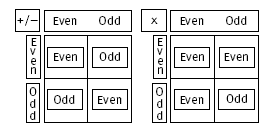This is a level 2 and 3 algebra link activity from the Figure It Out series.
A PDF of the student activity is included.
Click on the image to enlarge it. Click again to close. Download PDF (593 KB)
find patterns for adding odd and even numbers
find patterns for multiplying odd and even numbers
FIO, Link, Number, Book One, That's Odd!, pages 2-3
Activity One
In this activity, students explore the properties of odd and even numbers. This helps them to develop their understanding of number.
Using tens frames like those in the illustrations, the students arrange the numbers in pairs. This makes it easier to see the difference between odd and even numbers. Ask the students to visualise and then draw or show other odd and even numbers.
Have the students discuss and record on a wall chart or large piece of paper their description of what makes an odd number into an even number. Statements such as “an odd number is an even number plus or minus one” or, conversely, “an even number is an odd number plus or minus one” would demonstrate a good understanding of the relationship.
The pairs arrangement of even numbers shows that even numbers all have a common factor of 2. Encourage your students to see that all even numbers belong to the 2 times table.
A good way to record the different ways of joining odd and even numbers would be on a 2 by 2 matrix.
Activity Two
Encourage your students to notice that in the multiplication grid (above) for odd and even numbers, three of the options lead to an even result. Whenever one factor is the number 2, the result must be even because the 2 ensures a doubles or paired relationship.
A useful approach to question 1 is to have the students turn 6 x 4 and 8 x 3 into prime factors. They can then compare 3 x 2 x 2 x 2 with 2 x 2 x 2 x 3 to see that, in essence, they are the same.
In question 2, they should realise that any number that has a factor of 2 must be even, and indeed, any number that does not have 2 as a prime factor must be odd.
Activity Three
A good extension for studying even and odd numbers is to list a sequence of the numbers and find the general rule.
If they can see that the general rule for the nth term of even numbers is 2n (two times the number in the term sequence), the factor of 2 is clearly paramount, whereas with the odd numbers, the rule is 2n – 1 or the even number minus 1.
Answers to Activities
Activity One
1. They cannot make a complete set of pairs. There is always one left over.
2. Even. The odd (remainder) units combine to form a unit of 2 (a pair).
3. a. i. 18
ii. 22
iii. 104
iv. 14
v. 24
b. Two odd numbers add up to an even number.
4. a. The answer is even.
b. The answer is odd.
5. a. 4. Odd – odd gives even.
b. 6. Even – even gives even.
c. 7. Odd – even gives odd.
d. 7. Even – odd gives odd.
Activity Two
1. Even. Each set of eight can be divided evenly by 2.
2. a. i. 14 (even)
ii. 30 (even)
iii. 32 (even)
iv. 48 (even)
v. 27 (odd)
b. Even x even = even
Odd x odd = odd
Even x odd = even
Odd x even = even
Activity Three
1. a. Because they are all even numbers
b. The remainder is 1. 7, 19, 35, and 4 963 are all odd numbers. When odd numbers are divided by 2, the remainder is always 1.
2. a. 28 c. 96 e. 44



